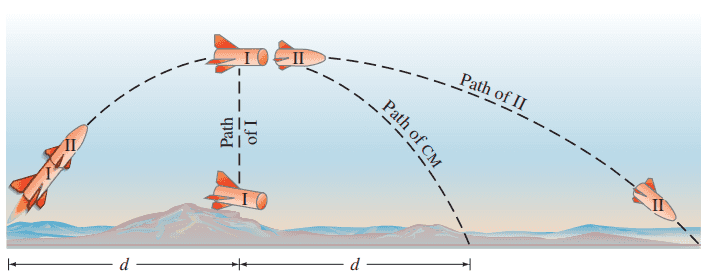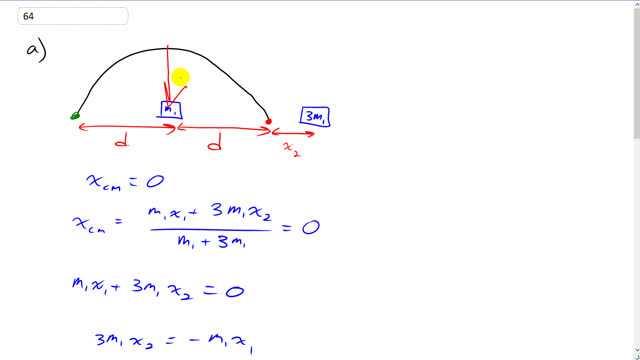
Suppose that in Example 7–14 (Fig. 7–28), .
- Where then would land?
- What if


In order to watch this solution you need to have a subscription.
This is Giancoli Answers with Mr. Dychko. So we are told that when the rocket is at the very top of its parabolic trajectory, it splits into two pieces and the piece number one falls straight down in the center here— midway between the launch point and the place where the center of mass lands— and then this other second piece, well, you know, gets pushed forward by the explosion that separated the two pieces. Notice that the center of mass lands here and it continues on its parabolic trajectory unaffected by the fact that the two pieces of the rocket split up because the forces that are involved there in that explosion, are internal forces; there's no external force on the system at all and so the center of mass just carries on unaffected. So the center of mass lands here although there won't be any crater there because the center of mass is just this concept, it's not a physical thing so there's no object that lands here. So this object does land here midway between the launch point and the center of mass—landing point— and this piece we have to figure out where it lands. So the center of mass, we'll call this point zero, this is gonna be our origin and then the center of mass is gonna be m 1 times x 1 which is the distance from this piece number one to the center of mass and plus the mass of this second piece which we are told is 3 times m 1 times its distance to the center of mass and all divided by the total mass and that equals 0 because we defined our x equals 0 point to be where the center of mass is which means we can multiply both sides by this denominator and we just end up with this: 0 times this denominator still makes 0 on the right hand side; on the left hand side, we have m 1x 1 plus 3m 1x 2. Then we are gonna solve for x 2 by subtracting m 1x 1 from both sides and we have 3m 1x 2 then equals negative m 1x 1 and then divide both sides by 3m 1 and we'll have the m 1's cancel and x 2 is negative x 1 over 3. Now x 1 is the displacement between this position or I guess, I should say the position of piece one with respect to this origin and that position is to the left of the origin which makes it a negative position. So we have negative d in place of x 1. So we have negative from our algebra of a negative and that's gonna make positive d over 3. That's x 2, the distance from this second portion of the rocket to this origin, the center of mass but the question is maybe better answered by saying compared to the launch point, where will this second piece of the rocket land? So it will land a distance of d over 3 plus 2d from the launch point. And so that's gonna make, when we multiply top and bottom by 3, and so on the top we get 6 and plus 1 makes 7d over 3 will be the distance from the launch point to where the second portion of the rocket lands. Now in part (b) suppose the first piece of the rocket is 3 times the mass of the second piece of the rocket, we are gonna do the same strategy of choosing the origin for our distance's here to be at the center of mass in which case the center of mass is located at the origin zero and this denominator disappears then and we are gonna solve for x 2, move this to the right hand side by subtracting it from both sides and we get m 2x 2 is negative 3m 2x 1. Divide both sides by m 2 and you get x 2 is negative 3x 1. So that's negative 3 times negative d so that's 3d and that means x 2 is gonna be 3d plus the 2d distance from the center of mass to the launch point total distance of 5 times d away from the launch point. And so when this piece in part (b) is really small and piece number one is 3 times the mass of piece number two, piece number two gets launched a lot further which makes sense.